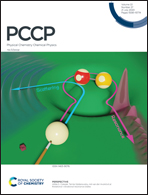Investigation of the thermal quenching of two emission centers in Sr9MnLi(PO4)7:Eu2+ using time-resolved technique†
Abstract
The thermal stability of the phosphors in phosphor-converted light-emitting diodes (LEDs) plays an important role in the practical application of lighting. Herein, the Mn2+-based red-emitting phosphors of pure and Eu2+-doped Sr9MnLi(PO4)7 (SMPO) samples were prepared using the high temperature solid-state reaction method. The crystal field environment around the Mn2+ ions was analyzed by combining the results of photoluminescence excitation spectroscopy and Tanabe–Sugano diagrams. By comparing the results of X-ray photoelectron spectroscopy, two additional bands centered at about 129.8 eV and 130.7 eV were found in the Eu2+-doped sample, which corresponded to the chemical states of P 2p3/2 and P 2p1/2. Two different sets of emission spectra were observed for Sr9MnLi(PO4)7:5%Eu2+ (SMPO:Eu2+) on employing the time-resolved technique. The emission peaks centered at 615 nm and 661 nm were attributed to Mn2+ and Eu2+ ions, respectively. The thermal quenching behaviors of Eu2+ and Mn2+ were investigated in the temperature range of 300–620 K and the thermal quenching mechanisms are given in this work. Systematic research on the luminescent properties of Eu2+ and Mn2+ ions in the SMPO:Eu2+ phosphor contributes to the understanding of the thermal stability and aids in the development of Mn2+-based red-emitting phosphors.



 Please wait while we load your content...
Please wait while we load your content...